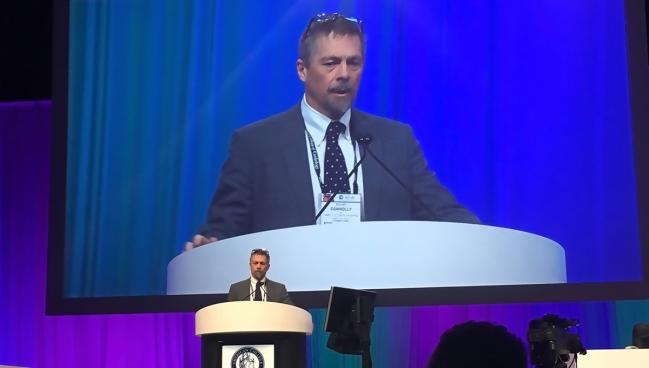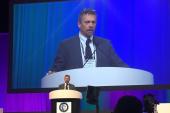Stuart J. Connolly, Clinical Trialist and Arrhythmia Medicine Pioneer, Dies at 75
Remembered as incisive, driven, curious, and kind, Connolly died Saturday of neuroendocrine cancer.

Stuart J. Connolly, MD (Population Health Research Institute [PHRI], McMaster University, Hamilton, Canada), who left his mark on the field of arrhythmia medicine through a steady stream of practice-changing clinical trials and breakthroughs, died Saturday from neuroendocrine cancer. He was 75.
“[Connolly] is recognized worldwide as one of the most impactful clinical investigators in cardiac arrhythmia management, having helped define our current practice for stroke prevention in atrial fibrillation, pacemaker therapy and the management of ventricular arrhythmias and cardiac arrest,” a PHRI announcement reads.
Connolly spent four decades at McMaster where he founded the cardiac arrhythmia service, served two terms as cardiology division director, and lead countless landmark clinical trials including, most recently, ARTESiA, COMPASS, RE-LY, INVICTUS, AVERROES, and ANNEXA. According to the PHRI, Connolly published more than 270 scientific articles and served on the editorial boards of several leading cardiology journals.
I really don't think there's another trialist in heart rhythm medicine that's covered such a breadth of areas, and for so long, at such a high level. Jeff Healey
Close colleague and frequent coinvestigator, Jeff Healey, MD (PHRI) told TCTMD that while Connolly pioneered therapies in everything from vasovagal syncope to post-surgical AF and led pivotal studies of pacemakers and ICDs, he is probably “best known” for his work in AF and stroke, starting with the original trials of warfarin, then leading two of the five major trials of the direct oral anticoagulants (DOACs).
“He had 30 publications as first or last author in the New England Journal including four in his last year of life. He was still going hard at it and it wasn't just atrial fibrillation and stroke,” Healey continued, citing his ARTESIA and ASSERT II collaborations with Connolly on subclinical AF, as well as the decisive surgical left atrial appendage occlusion trial, LAAOS III, led by Richard Whitlock, MD (PHRI), calling these “Connolly originals”—ideas he hatched up in the late nineties that came to fruition decades later. “Anywhere that there was a good clinical question, Stuart seemed to have a presence. . . . I really don't think there's another trialist in heart rhythm medicine that's covered such a breadth of areas, and for so long, at such a high level.”
Outside of his own field, Connolly took pains to encourage original ideas and rigorous research in those he mentored, said Harriette Van Spall, MD (PHRI), crediting Connolly with recruiting her to McMaster. “Stuart was one of the most incisive minds I have had the privilege of encountering. He thought with a great level of clarity, and he nurtured my love for research methods,” she told TCTMD. “He valued intellectual independence, which was so refreshing. In some groups, you survive and grow by being under the umbrella of someone senior, but I had a different research focus than his; he didn't encumber me with expectations to do what he was doing, and that was a gift. In a tough environment, he advised me to drown out the noise, write competitive grants, focus on what I could control, and just keep going. This has stood the test of time.”
“Stuart was always one of my favorite collaborators,” C. Michael Gibson, MD (Baim Institute for Clinical Research, Harvard Medical School, Boston, MA), told TCTMD. “Of course he was exceptionally bright and talented, but I valued and admired his no nonsense direct approach that placed a premium on honesty and clarity. He made enormous contributions not only to the field of anticoagulation, but also to the field of anticoagulation reversal in our work together on Andexanet. He had a great sense of humor. I will miss Stuart greatly as will many others, I'm sure.”
Beyond Academia
Everyone who spoke with TCTMD also highlighted the fact that Connolly’s drive and dedication extended beyond his academic accomplishments, noting in particular his athleticism. “He was one of those unique people who really excelled at the things he chose to do,” said Whitlock, noting that Connolly had taken up triathlon in the last decade of his life, taking second place in his age category for the half Ironman at an international level in 2022 and “kicking butt” on hills against cyclists half his age.
He also was frank and unflinching in his standards for excellence. “When something wasn't right or someone was pushing some kind of ‘not robust’ evidence—some concepts that were not supported by evidence within medicine,” Whitlock said, “he would call it out, and he would have no qualms about calling you out.”
He was present in the lives in which he was absolutely irreplaceable. Harriette Van Spall
Van Spall also pointed to his role as a husband, father, son, and sibling, particularly the “striking and very moving lesson” he provided to others at PHRI in the time he spent caring for his wife, cardiologist Elaine Gordon, who died of cancer in 2020.
“He stepped away from certain things to be there for Elaine, to be present with love,” Van Spall said. “Beyond the science, beyond his way of transforming minds, beyond the way he transformed care in atrial fibrillation and thrombosis, beyond what he did as a division director—he was present in the lives in which he was absolutely irreplaceable.”
Whitlock, too, said he could expect a call from Connolly if he noticed that the work of his mentee was taking him away from home too often, reminding him it was important to spend time with his family. If Connolly was concerned about industry exerting undue influence over him, Whitlock would hear about that, too.
“That's how I learned my ethics and how to ensure that I maintained my standards while working with industry partners,” he said. In everything he did, Whitlock added, Connolly “would always just cut right to the point. Sometimes that could be somewhat insulting to people, but he got things done by doing that. He would really see the crucial points and crucial questions to be answered, and he had the expertise that a question [got] answered robustly.”
“Whatever he did, he did perfectly, or he did the absolute best that he could do it,” Healey said. That applied to his athletic pursuits as much as it did his family and the many trainees he invested in over the second half of his career. “He didn't waste time on small questions. If he was going to address the question, he would design the best possible trial, no matter how much it cost or how complex it was.”
And then he’d get it done.
Connolly leaves behind four children, five grandchildren, two siblings, and his partner Susan.
According to the Hamilton Spectator, donations can be made in lieu of flowers to the Canadian Neuroendocrine Tumor Society https://cnets.ca/.
“Or just send flowers,” the obituary reads. “Stuart loved flowers.”
Shelley Wood was the Editor-in-Chief of TCTMD and the Editorial Director at the Cardiovascular Research Foundation (CRF) from October 2015…
Read Full Bio



Comments